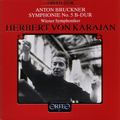ORFEO International
News
April 2008
Herbert von Karajan's 100th Birthday
Whole 
Herbert von Karajan
Foto: Orfeo Internationalconferences 
ORFEO CD C 298 922 Iare being held to mark the centenary of Herbert von Karajan’s birth, while existing biographies and discographies, with their critical and uncritical approaches, are compared and relativized, allowing new standpoints to emerge. In this way, Karajan’s recordings have become an object of speculation, and their status in the history of the performing arts and within a wider setting has been discussed, opening up the way to further controversy and allowing them to be seen within the most disparate contexts. In recent months and years, Orfeo has been able to release an increasing number of live recordings that connoisseurs of the conductor’s art regard as milestones in his career, even though towards the end of his life he himself often preferred to revise his interpretative approach by performing and recording these works all over again. One exception was his performance of Richard Strauss’s one-act opera Elektra from the 1964 Salzburg Festival 
ORFEO CD C 603 033 D(C 298 922 I)
ORFEO CD C 615 033 D. He knew that he would never again surpass his cast on that occasion – it included Astrid Varnay, Martha Mödl, Hildegard Hillebrecht, Eberhard Waechter and the Vienna Philharmonic Orchestra – and so he never conducted it with any other cast. Much the same is true of the first night of Wieland Wagner’s new production of Tristan und Isolde from the 1952 Bayreuth Festival. Here, too, cognoscenti argue that the intensity of the orchestral playing and singing, especially Martha Mödl and Ramón Vinay as the lovers, could not possibly be increased even with 
ORFEO CD C 275 921 BKarajan’s magical sonorities
ORFEO CD C 232 901 B and casting policies (C 603 033 D). That he could achieve both these aims in the most profligate manner is clear from the most recent addition to his discography on the Orfeo label, Mozart’s Don Giovanni from the 1970 Salzburg Festival (C 615 033 D). With Nicolai Ghiaurov in the title role, Gundula Janowitz and Teresa Zylis-Gara as the two leading ladies and, once more, the Vienna Philharmonic, Karajan had assembled around him an outstanding ensemble that allowed him to create a Mozart style of legendary luxuriousness, albeit one that would hardly be regarded as authentic today. 
ORFEO CD C 231 901 BThe early live recordings
ORFEO CD C 729 081 B of his concerts in post-war Vienna all capture a fiery temperament that was sacrificed in later years to an overriding concern for sonority. The tempestuous élan of Tchaikovsky’s Fourth Symphony that is driven forward as if with insatiable desire, thanks in part to the Vienna Symphony Orchestra, is positively amazing, especially when set alongside Handel’s Concerto grosso op. 6 no. 12, grandiloquently performed here in a programming decision that now seems somewhat bizarre (C 275 921 B). Karajan’s live recordings of Hindemith’s Mathis der Maler Symphony and Beethoven’s Seventh Symphony (C 232 901 B) are similarly notable for their transparency and gossamer lightness when compared to the denser tone colours of his well-known studio versions. Conversely, his 1954 live recording of Bruckner’s Fifth Symphony (C 231901 B), 
ORFEO CD C 728 082 Blikewise made with the Vienna Symphony Orchestra, already gives us a foretaste of Karajan’s later style, with its tendency to indulge in immoderate solemnity. In this respect it is very different from Orfeo’s two most recent recordings with Karajan and the Vienna Symphony Orchestra, Beethoven’s Ninth Symphony (C 729 081 B) and the Verdi Requiem (C 728 082 B), both of which additionally document the conductor’s lifelong association with the Singverein of the Gesellschaft der Musikfreunde in Vienna.
top |